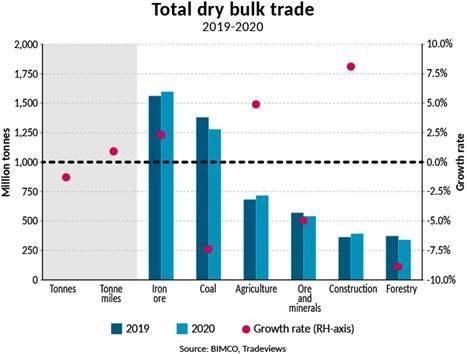
The turbulence of the past year has in many ways clouded the underlying fundamentals in the dry bulk shipping market, but with 2020 now behind us, we are in a better position to establish an overview of expectations for 2021.
Overall, total tonnes transported by the dry bulk shipping industry fell by 1.3% to 5.49 billion tonnes, from 5.56b in 2019, which is however still higher than the 5.46b tonnes shipped in 2018. China has further cemented its position as the dominant player in dry bulk shipping with its imports now accounting for just shy of 50% of the market when measured in tonne-miles.
This overall drop in tonnes marks discrepencies between different dry bulk commodities. Of the three main commodity grous: iron ore, coal and agriculture, coal is the only one to have fallen; down 102.2 million tonnes from last year (-7.4%).

Iron ore and agricultural goods have, on the other hand, risen in 2020, up by 36.9m tonnes (+2.3%) and 33.3m tonnes (+4.9%) respectively, cementing iron ore’s position as the highest volume dry bulk good. In percentage terms, the biggest growth has come from construction, which grew by 8.1% in 2020, but as absolute volumes are much lower, this translated into an extra 29.6m tonnes. The largest commodity in the construction category is cement, which saw a 13.4% increase between 2019 and 2020. China accounted for half of this 21.5m tonne increase, as the country saw its seaborne cement imports rise by 52.2% (12.7m tonnes).
At the other end of the scale, the largest percentage drop came from foresty, down 8.9%, or 33.0m tonnes. Half of this drop comes from wood in rough, down by 14.9 million tonnes (-17.4%). 10.6m tonnes of the 14.9m loss came from lower imports into China.
”For dry bulk shipping, the year can be divided in two, with lower volumes and earnings in the first half followed by a recovery in the second, as China split from the rest of the world, boosting tonne and tonne mile demand, and sending freight rates to profitable levels. June was the turning point as volumes reached their highest point of the year, and earnings jumped, especially for Capesize ships,” says Peter Sand, BIMCO’s Chief Shipping Analyst.
In many ways following the narrative of the year, there is a split between China and the rest of the world. Splitting up the two in terms of dry bulk trade, China grew strongly last year, with volumes rising by 95.3m tonnes (+5.2%). Amongst other things, Chinese imports of iron ore and soya beans have risen by 7.1% and 12.0% respectively.
The strong growth in Chinese imports has however not been enough to make up for the fall in imports by the rest of the world when measured in tonnes. Here, demand fell by 4.5%, amounting to 167.7m tonnes, overshadowing the growth in China.
The increase in Chinese imports means that the tonne mile demand from these accounted for 48.5% of total dry bulk tonne miles in 2020, up from 44.7% in 2019. In comparison, when measured in tonnes, China’s share has risen from 32.8% in 2019 to 34.9% om 2020.
(Source: BIMCO)



